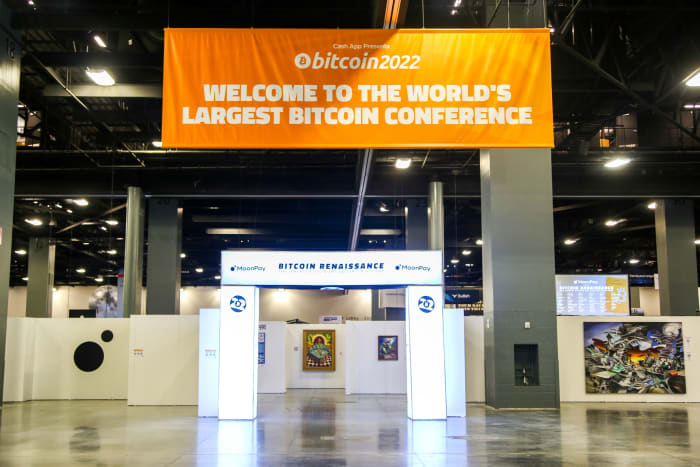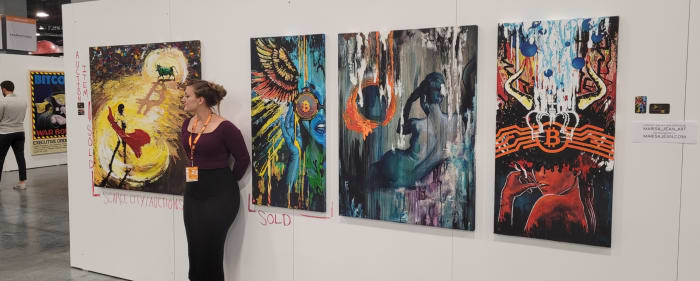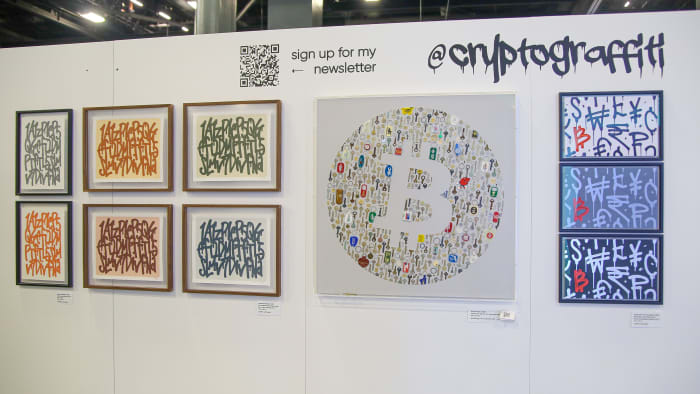[ad_1]
This article is an unofficial follow-up to a previous article on a similar theme.
The Bitcoin Renaissance is well underway and the art gallery by the same name at Bitcoin 2022 was a prime example.
The Bitcoin Renaissance gallery offered a small glimpse into the future of the kind of influence Bitcoin will have on creative works and vice versa. Artists from all over the world gathered to exhibit their physical and digital artwork, auction off pieces and some of the participants gave talks on a small stage next to the gallery.
The importance of Bitcoin and its connection to art cannot be overstated. Art was one of the major factors of the previous Renaissance which led to a significant overhaul in human progress and culture. According to one interviewee, the three main components of the previous successful Renaissance were decentralized money, decentralized communication and decentralized identity. This article attempts to summarize those factors and compare them to the current markers which indicate we are in the midst of a brand new era with similar characteristics. The Bitcoin Renaissance is real and we are only beginning to scratch the surface of what it may look like.
Decentralized Money And Communication
I had a chance to talk to many of the exhibiting artists as well as one of the presenters on the gallery stage. A historian specializing in the time period between the late Middle Ages and the Renaissance, Joshua Rosenthal, Ph.D., explained some of the particular characteristics that made the last Renaissance lasting and noteworthy. He mentioned that there were dozens of renaissances throughout history, but none were as successful as the Renaissance from the 14th-17th century because the previous ones didn’t utilize decentralized technology and weren’t tied to money or communication.
The Renaissance period that most people are familiar with had a lasting stronghold on history because the people of the time took advantage of a newly rediscovered monetary system of double-entry bookkeeping. This type of distributed ledger allowed for people to access capital by having a mobile form of debit and credit. Talking about this double-entry booking, Rosenthal said, “That essentially removed the middleman or it allowed for a decentralized middleman; the middleman being the Church.”
The Church was the epicenter of power. According to Rosenthal, “It was hard to tease apart the religious and the political aspects of society.” The advent of this new double-ledger technology created an opportunity for people to travel because their money was able to move with them.
The rediscovery of double-entry bookkeeping and subsequent decentralization of ledger technology in the late Medieval period led to physical mobility of the populace. Similarly, Bitcoin provides a new way for humans to distribute a global ledger and presents the possibility for jurisdictional arbitrage because wealth is not tied to any geographic location — so long as Bitcoin users are able to keep track of their seed phrase, which allows them access to their wealth anywhere with an internet connection.
In addition to decentralized money, the invention of the printing press allowed for decentralized communication. Rosenthal described the average medieval person’s life as, “Not only could you not read, could you not write, if you wanted to share a document of power, it was permissioned.” Essentially, before double-entry bookkeeping and the printing press, the Church had power over everything.
“They [the Church] were really good at exercising dominion over evil, keeping people in their place and part of their tools were regulating money, regulating communication, but you, as a medieval person, it wouldn’t have occurred to you that there could be something else.” –Joshua Rosenthal
The printing press gave people the ability to share ideas at scale. Before its invention, all documents were distributed by the Church, but now there were decentralized vectors of transmission for ideas. Most of what was printed was one big image which Rosenthal likens to current-day memes.
“The people are seeing some images for the first time. It’s not just a realistic representation. It means something and it’s crazy. Basically the content of the images displayed the hierarchy as illegitimate. They printed images to show viscerally that the previous world was illegitimate and to show worlds that were unimaginable at the time.”
While many people associate the printing press with mass production of Bibles and longer texts, Rosenthal says that it was actually the widespread sharing of images which was the main way people were able to experience something that was completely beyond belief. Below is an example of an image he shared from his presentation. “The Birth And Origin Of The Pope” shows a female demon excreting a pontiff. This type of crude image would have been shown in a communal setting, such as a town square, and the observers would share in an experience that upended their ideas of the current power structure.
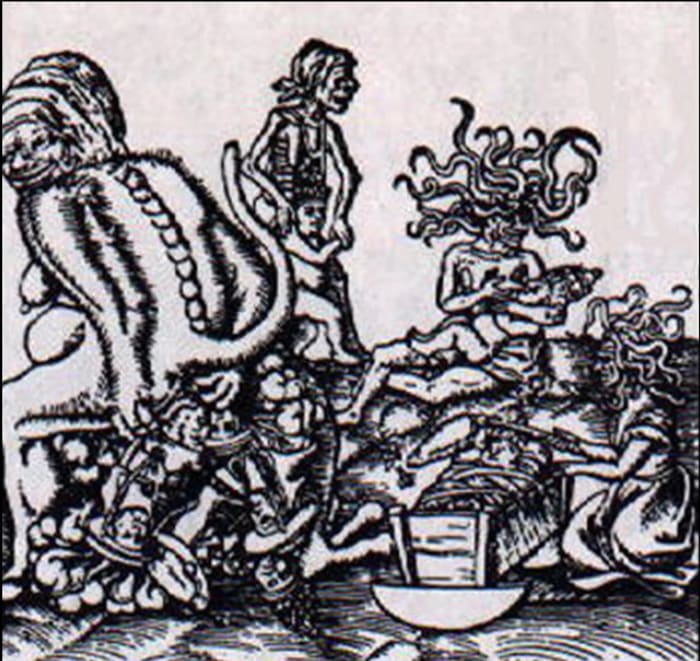
(Source)
This type of mematic expression is a way of creating a new image for what could be possible and the decentralization of the printing press is what actually made it possible.
Again, Rosenthal explains the way this technology allowed for the mass sharing of ideas, “The printing press allowed people to share an idea. You can put it in the backroom of the best butcher shop and print off tens of thousands of things in a week. And then of course the city officials tried to know your customer (KYC) the printers, some complied, but others said, ‘No, we’re not going to do it.’” By working anonymously and in a decentralized manner, ideas were able to be spread far and wide.
Reflecting The Structures Of Power
I spoke with Marissa Jean to discuss how she started disseminating Bitcoin-related ideas through her art. “I just started incorporating emotions or basic feelings into the painting. For example, the first one I ever made was called ‘Inspiration,’ I started chronologically. I asked myself, how did I feel when I first got into Bitcoin?”
Jean used these emotions to portray her journey through Bitcoin. “I connect my emotions and my interest in Bitcoin because it’s kind of become a pastime of mine. And so since it’s on my mind anyway, I might as well paint it.”
Painting about Bitcoin and its ethos was easy for Jean because “Bitcoin has changed many people’s lives for the better. And so it’s a subject worth painting about that has different levels of meaning for everybody.”
The layers of meaning and direct representation of Bitcoin in her art as well as other Bitcoin-themed art in the gallery paves the way for observers to connect to it in ways that are meaningful to them individually. It also provides an opportunity for viewers to begin questioning the current power structures of today.
In discussing the Bitcoin Renaissance gallery, Jean reflected, “You see a lot of artists interested in portraying the fact that the U.S. dollar is failing them, losing value and that Bitcoin is their savior. You see a lot of rebellious stuff, you know, rising to the occasion or fighting against oppressors. We are in this phase where we are against the oppressor. So that [type of painting] is the norm, but it’s also staying weird; the memes aren’t gone, they’re just ingrained. There was so much amazing, beautiful oil, Renaissance-style art there that was a freaking Pepe.”
This brings us back to Rosenthal’s point about the memification of art that presents the world in a completely ludicrous way, in the process flipping the current paradigm on its head, and then offers a new framework for viewing the world.
Conceiving The Previously Unimaginable
The theme of creating worlds that were previously unimaginable is something with which the artist Sarah Meyohas is quite familiar. Inspired by the immaculate conception of Bitcoin, Meyohas said, “It was like a new creation of currency, in a way that has not been done before. Bitcoin was the ultimate inspiration because it was a re-imagining of value.”
Meyohas is not new to Bitcoin. In her personal quest to understand subjective value, including the etymology of financial terms, Meyohas created Bitchcoin in 2015 and backed the tokens by photographs from her “Cloud of Petals” exhibition, subsequently releasing the first example of tokenized art on a blockchain.
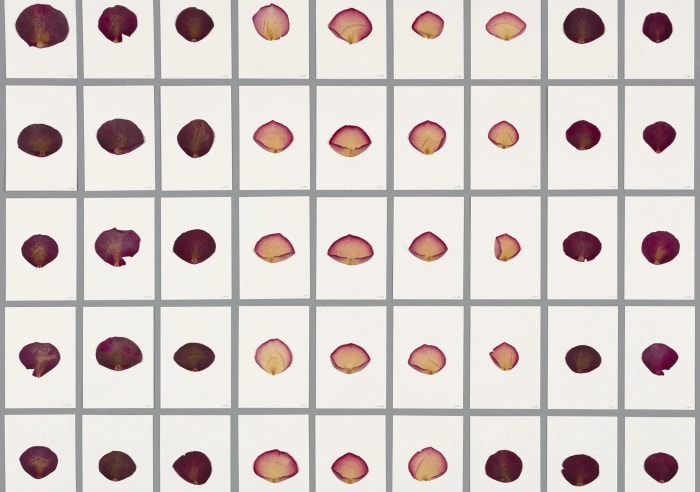
Pressed petals from Meyohas’ Cloud of Petals
Meyohas recently made a Bitcoin hologram piece that was displayed in the Bitcoin Renaissance gallery and described how this intangible asset was turned into a physical work of art. “Bitcoin is both hyper-physical and completely nonphysical at the same time. So that’s part of what I was really excited about, making holograms for Bitcoin. Bitcoin is the one cryptocurrency that has this image that’s super strong and it has this image that feels like it should be physical.”
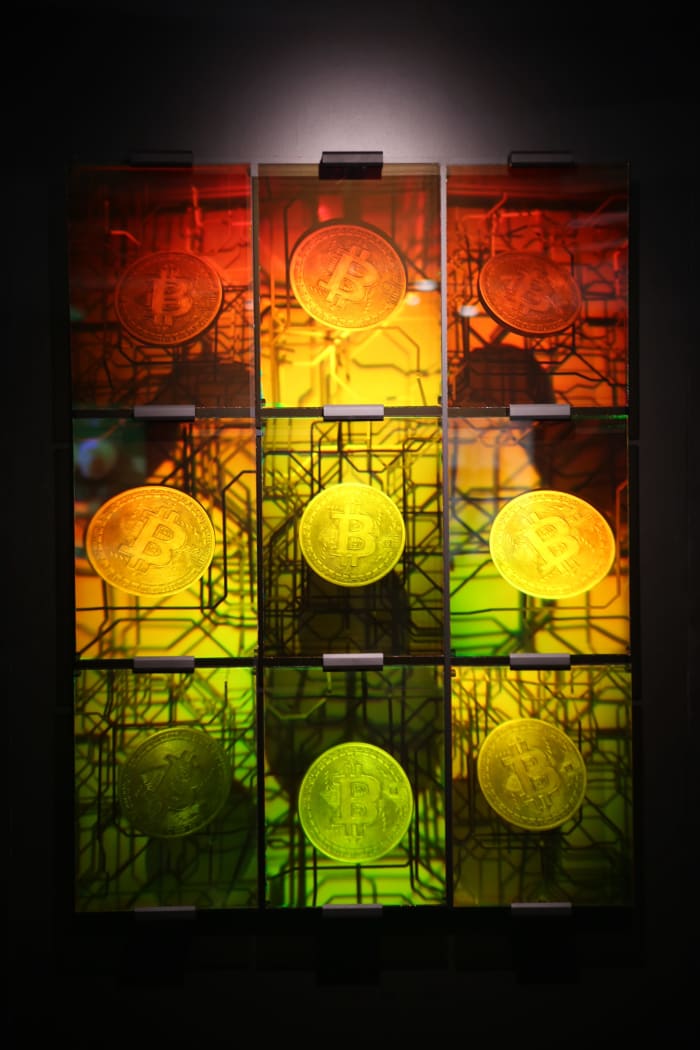
Meyohas’ “BTC Interference, 2022” Description: 9 Denisyuk holograms
By marrying the metaphysical and the physical, Meyohas is able to create a vision for new possible realities — visions that were unthinkable before Bitcoin.
In her “Speculations” series, she created a story of the new innovation of Bitcoin’s timestamping through the use of distributed consensus and blockchain. “Speculations bring time and space together. The Bitcoin blockchain is an innovation of time. It’s timestamping with a new agreement on time.” (For more about Bitcoin and time, read Gigi’s “Bitcoin Is Time.”)

Meyohas’ Liquid Speculation #1, 2021
Bitcoin offers artists the opportunity to present a new version of reality, inextricably tied to this completely new way of determining value.
“It’s an intense cultural development and that gets put into art. But the thing that’s interesting about Bitcoin that does appeal to artistic creation is it’s like the Genesis story of Bitcoin has lore and magic to it and feels like itself, a moment of creation.
“True art is made in a pure way; you’re not making art to become a gagillionaire, you make art to create something radically new; that is totally avant-garde; that presents the world in a new way to people.” -Sarah Meyohas
The artists in the Bitcoin Renaissance gallery are presenting new possibilities for viewers to demonstrate worlds that are possible, but which many observers may not even be aware could potentially exist. In his talk, Rosenthal explained,
“Both then and now, art is more than it seems, more than real. The art in the Bitcoin Renaissance gallery is not just pretty, but a way of defining identity and recreating our reality. The art points to something beyond our current perceptions, the new, the possible, and the world to come. In a real way, the image is more real than the thing itself as it gives expression and thereby reality to the idea, concept and construct. Medieval you could not envision self-sovereignty until faced with a technologically empowered art that reshaped your identity and recreated your world.
“Art points beyond itself to the possible reimagining of a new world, with failing institutions reformed through self-sovereignty … then instantiating that reality.”
Reshaping Identity To Re-create The World
In addition to the decentralized nature of money, with double-entry bookkeeping and communication with the printing press, Rosenthal named decentralized identity as the final trait of the last Renaissance period that made it lasting and effective. The early stages of this shift in identity during the Middle Ages happened once peasants saw imagery that reshaped their worldview. During the shift, this restructuring of identity gave medieval people a new perspective on potential realities that were impossible to imagine before the advent of the printing press.
Many times throughout our conversation, Rosenthal likened Sathoshi Nakamoto’s white paper to Martin Luther’s “95 Theses.” By pointing out the inconsistencies with the Church selling indulgences in order to finance war, the whole system fell apart. “He pulled the plug from the economy of the hierarchy … He pulled that pin and like, it’s just a little thing, but then you realize the whole thing unraveled. Then you read the Bitcoin paper and you realize the whole financial system unravels.”
Before posting his theses, Luther was an unknown figure. After he nailed his theses to the church door, Luther continued to write using a pseudonym. He essentially took down the economy of salvation and had to go into hiding to avoid being arrested and potentially killed. Rosenthal shared, “It was a monetary attack. What he did though, was on the legitimacy of money, which obviously ties into the legitimacy of authority.” Again comparing Luther to Nakamoto, Rosenthal ponders if the publishing of the “95 Theses” bringing down the legitimacy of the Church is exactly what is in the process of happening since the publishing of the Bitcoin white paper bringing down the legitimacy of the current financial system. (Interestingly, Luther posted his “95 Theses” on October 31, 1517 and Nakamoto published the Bitcoin white paper on October 31, 2008.) Due to the anonymity of the internet, the identity of Satoshi Nakamoto remains unknown. The use of Bitcoin in conjunction with the internet is allowing for a new type of decentralized identity.
Decentralized Pseudonymity
One artist I spoke with is extremely familiar with remaining anonymous behind his work; I sat down with cryptograffi to discuss his perception of Bitcoin and its influence on his art. He shared, “When I saw the potential for Bitcoin and the dearth of art and design in it, I knew that there was an opportunity there. And also I was just extremely passionate about it. It’s a never ending source of inspiration. I think, especially in this society, we need this [inspiration]. I don’t want to raise kids in a world without bitcoin. It’s hope for me; I don’t know what I’d be doing without it.”
By remaining shielded behind his pseudonym, cryptograffiti is allowed to let his work speak for itself, “The typical idea with art that you’ll oftentimes hear is ‘you want to ask something that’s recognizable,’ but I pushed back against that because usually like the unsaid part of that is, ‘so that collectors will know that it’s your work.’ It’s more from an investment standpoint, but art, to me, is not about trying to make work that is easily bought. It’s about just doing what you’re passionate about and what resonates with you. And it just so happened that mine is a concept that tries to push me going forward.”
This freedom has also given him time to reflect on Bitcoin and the ways in which its decentralized nature and ability to process borderless, nearly instantaneous transactions. Cryptograffiti gave encouragement for other artists to accept bitcoin for their work in order to “get into a circular economy and get past this stage of people not wanting to spend bitcoin at all. People will use the Lightning Network more readily if they’re also earning in Bitcoin.”
“I think as we see how Bitcoin has shaped up over the years and proven itself as a store of value and it’s provided more inspiration in many different ways for artists to take from it. It’s great to look at the work here on display at the conference from different people in different parts of the world and see what Bitcoin means to them because it might not be the same for everyone.” – cryptograffiti
By using a pseudonym and having the ability to remain anonymous, cryptograffiti was able to find a path towards sovereignty through Bitcoin. “First of all, the self-sovereignty thing, where I just want to be able to take my ideas, bringing them to life and not have to work for anyone else to do exactly what I want. Bitcoin has allowed me to do that.”
Decentralized identity can mean different things and it’s likely we are still only beginning to scratch the surface of what that looks like. For some, the first steps are the ability to use a pseudonym. As society moves further into the Bitcoin Renaissance, we may see more markers of decentralized identity, such as the Decentralized Identifiers being explored by Impervious.ai or even ways to log in to websites through LNURL-auth, which uses a public key and doesn’t give any personally identifying information. This piece of the Renaissance puzzle is still being explored and it will be exciting to see the trajectory.
Conclusion
The Bitcoin Renaissance gallery demonstrates how Bitcoin as decentralized money can inspire a new kind of decentralized communication and identity through art, paving the way for a new vision of the future and the means to make it a reality.
“The art in the Bitcoin Renaissance gallery is not simply visuals or a way to express wealth, but rather a means to express agency and instantiate a new world via recreation. What we experience in this gallery is identity, coordination and sovereignty. The media endemic to the nature of this technology, the value of Bitcoin, inextricably linked with its meaning. The Bitcoin Renaissance is not another renaissance, but a new kind of recreation — a revolution of renaissances … Art resists, toppling failing institutions.” –Rosenthal
While we are most likely still going through times analogous to the late Medieval period, Bitcoiners are bearing witness to the early stages of a new Bitcoin Renaissance. Historians will look back on this time period of failing institutions, debased fiat money and a misaligned incentive structure with incredulity. We are currently going through major changes in the structure of society, with most people unaware.
Rosenthal closed his talk by stating, “The people that are in the greatest periods of change are the least likely to notice it.”
It’s time to look closely at the art and envision the new reality we can create — thanks to Bitcoin.
This is a guest post by Craig Deutsch. Opinions expressed are entirely their own and do not necessarily reflect those of BTC Inc. or Bitcoin Magazine.
[ad_2]
Source link

